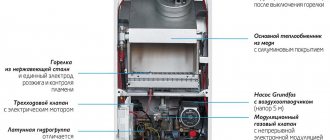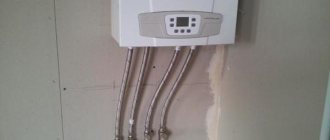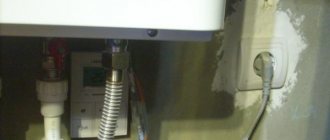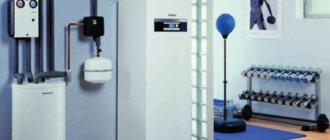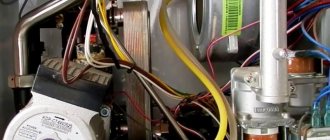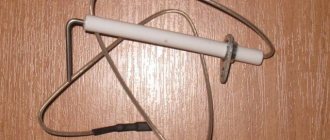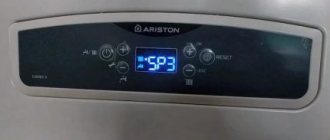The manufacturer of heating boilers "Navien" is a leader among manufacturers of heating boilers on the Russian market. Eleven years of work in the Russian Federation, repeated receipt of the “people's brand” nomination attract a large number of Russian buyers. Accordingly, over time, a large number of users encounter errors and malfunctions of Navien boilers. Many of them can be eliminated at home. We’ll talk about this in our material.
Features of Navien boilers
There are several other reasons why more than a million wall-mounted boilers of this brand have already been purchased in Russia. The product is perfectly adapted to Russian realities: it is highly resistant to low temperatures and other aggressive environments. Protected from network voltage sags. It is possible to connect boilers in a cascade chain. Elegant shape, design that fits into any Russian interior. The boilers come with a 36 month warranty. The manufacturer has established the supply of spare parts for service centers in the Russian Federation to eliminate breakdowns. Navien boilers are highly reliable; it is very difficult to permanently break the boiler. The boilers have an intelligent problem detection system built into the boiler system; using the error number, it is possible to determine what is broken in the boiler.
How to properly adjust and start
Procedure:
- The boiler startup procedure begins with filling with water. Gas dual-circuit units do not need to install additional devices, so you just need to open the make-up valve and increase the pressure to 1.5-2 At.
- After this, the valve is closed, air pockets are removed from the system and on the unit itself, for which Mayevsky valves on the radiators and an air valve in the boiler are used.
- Then you need to bleed the air from the circulation pump. The casing is removed and the water heating controls are turned on. Specific sounds appear, indicating the operation of the system. On the pump, gradually unscrew the screw in the middle until water appears. This procedure must be done 2-3 times, after which the air from the pump will be completely removed.
- As soon as the circulation pump is brought into operation, the burner will start electronically and the heating system will begin to function.
Basic list of Navien boiler errors
For more convenient communication between the boiler and the user or service worker, unique error codes have been developed to indicate a problem in Navien gas boilers. Eighteen errors can be independently detected by the system. Inspiring diversity can pinpoint the problem. But product users will see a small part of possible messages from the boiler communication system. Decoding the main errors of heating systems:
- “02” – Stop coolant circulation
- “03” – Ignition problem
- “16” – Heat exchanger overheating
These malfunctions are the most common, the reasons are: poor quality of centralized water supply, careless attitude of boiler users, increased network voltage. But this is not the end of the world, all problems are solved.
Other Navien boiler malfunctions:
- “01” - Boiler overheating
- “05” – Temperature sensor failure
- “06” – Temperature sensor short circuit
- “08” – Short circuit of the water supply sensor
- "09" - Turbine failure
- “10” - Chimney clogged
- “13” - Flow sensor failure
- “15” - Exceeding the maximum permissible voltage
- “27” - APS sensor failure
The boiler does not work in DHW or heating mode
And finally, situations when the boiler does not operate in a particular mode. They happen much less frequently compared to others. In this case, it is likely that the boiler will need to be diagnosed by a specialist. The process of ignition and operation of the boiler in different modes is virtually the same, with the exception that different modes may have different power. In hot water preparation mode, the boiler power is usually full, but in heating mode it can be minimal. You can read about problems in the operation of the DHW mode in a separate article.
Eliminating common errors
Let's look at the common errors of Navien boilers and figure out how to fix them.
Error “02” - stop coolant circulation
The filters of the boiler or heating system often become clogged, this leads to the appearance of two unfortunate numbers of fault 02. It is also very likely that the cause of this error is the main heat exchanger clogged with scale. These troubles occur due to the high hardness of the water used to operate the device. The ubiquitous scale affects the most important parts of the device, stopping operation. To resume boiler operation, you must:
- Clean the filters in the boiler itself and the heating system.
- Remove the heat exchanger from the housing.
- Prepare an acid solution to destroy scale on the heat exchanger.
- Place the heat exchanger in a container with an acid solution.
- Wait for the chemistry to do its job.
After simple manipulations, if you have the necessary ingredients and knowledge, you can independently get rid of error “02” of the Navien gas boiler. Monitor the circulation sensor inside the boiler, wash the filters regularly to avoid unpleasant surprises.
Error "03" ignition problems
It says either a simple lack of gas or a broken gas valve. Let's look at the second option. Navien boilers are equipped with the most reliable Japanese gas valves; they are difficult to break when using the boiler perfectly and correctly. But if the mains voltage is ten to twenty volts higher than 220 volts, the coils inside the boiler will turn black and the valve may break completely. To fix this breakdown, you will have to buy a completely new valve and replace the broken part. Extreme care is required with the network voltage. Increased levels can harm more than one boiler.
Error “16” overheating of the main heat exchanger
Occurs when the boiler’s internal thermometer records a temperature of 95 degrees. This Navien boiler error may indicate several breakdowns of the boiler system. Again, the main heat exchanger is clogged with scale due to hard water from the centralized water supply, which causes the device to heat up to a high temperature. Or it could be an insulation problem with the main heat exchanger. The fact is that if you actively use the boiler for five years and do not provide proper care, it is likely that the gaskets, which should not release the heat of the heat exchanger, begin to blow out. Warm air blows directly onto the thermometer - an error occurs. To eliminate error “16” you need to clean the main heat exchanger in an acid solution and restore its insulation. But it is better to prevent this problem by regularly carrying out boiler maintenance; if possible, then using water that is safer for equipment.
Do-it-yourself replacement of units
Some units and components are replaced or cleaned independently. It is recommended to order and purchase spare parts from Navien dealers.
Before opening the lid, it is recommended to disconnect the boiler from the water, gas and electricity supplies. Here are some examples of replacement.
To replace the fan, and it is only replaced as an assembly, you should:
- Disconnect the gas line.
- Remove the hose between the fan and the air sensor.
- Disconnect the connectors (there are two of them) connecting to the control unit.
- Unscrew the screws (3 pcs.) and pull out the fan. Next, install a new one and return everything to its previous state in the reverse order.
In the video you can see how to flush the Navien boiler:
If you change the main heat exchanger, then you need to do it as follows:
- First remove the following units - gas supply pipeline, ignition transformer, fan and overheating sensor.
- Then disconnect the grounding, unscrew the fastening screws and remove the combustion chamber.
- Next, unscrew the mounting screws (8 pcs.) and remove the flue gas collector.
- After this, unscrew the screws holding the combustion chamber cover (9 pcs.) and unscrew the screws connecting the heat exchanger to the combustion chamber body (6 pcs.)
- Pull out the heat exchanger and install a new one, performing the steps in reverse order.
If the heat exchanger is cleaned and there is no damage, then use the old one. But be sure to check the integrity of the ceramic seal. If necessary, it is changed.
If the boiler is humming, what should you do?
All of the above errors usually lead to a complete stop of the boiler, but a much more common, less destructive problem is an unpleasant sound from the equipment. Annoying noises will cause headaches and increased stress. It’s clear that a properly installed and operated Navien boiler should operate silently; humming is a symptom that can warn of a major malfunction in the future.
Let's look at the most popular sources of hum:
Malfunction of the boiler ventilation system
If the boiler has to be in a dusty basement or you simply use the device for a long time without proper care, then a large amount of dust accumulating inside the housing can disrupt the ventilation. This is perhaps the most common cause of hum in old equipment, but we must not forget that the problem may be a lack of lubrication. To avoid unpleasant sensations from extraneous sounds, remove dust from the boiler and lubricate it regularly. Otherwise, you will have to call a specialist, and perhaps change the fan itself.
Hard water sediment
As with many of the problems discussed earlier, hard water can play a key role in problems related to humming inside equipment. Scale first affects the heat exchanger, and then the entire apparatus, reducing all its positive qualities; due to the narrowed passages for water supply and the abundance of steam, a strange hum appears. An acid solution will help get rid of scale in a Navien boiler, only this time you will have to treat all the parts of the boiler - it is better to entrust this to a specialist.
Water oversaturated with oxygen
Using a natural circulation system, you are at risk of hearing unpleasant sounds, even using the latest boiler. The boiler itself is not in danger, and it will produce the best efficiency while operating stably, but the sound bothers the owner. The cause of the noise is air bubbles bursting inside the heating system. It is easy to get rid of noise by replacing the natural circulation system, improving the boiler system with membranes.
Gas pressure
Reduced gas pressure inside the system causes annoying noise in the room. Gas deficiency forms air pockets, the speed of water movement decreases, and the apparatus overheats. To correct the problem, you just need to change the pressure to an acceptable one equal to two atmospheres. These manipulations should be performed by a trained professional.
Other reasons
Other causes of unpleasant noises in the Navien boiler may be minor reasons. Strange knocking noises associated with the presence of air in the system. Despite the quality of Navien boilers, no one is immune from mistakes, and ordinary factory defects can be the cause of your headaches. Check the product carefully, make a return, warranty exchange.
The best way to avoid problems, breakdowns, hums, errors and other malfunctions is prevention. Regularly undergo a technical inspection of your Navien gas boiler, wipe off dust, add grease, clean out debris, have spare parts, connect clean water, set up the circulation system and you can avoid many unpleasant problems.
Do not try to completely determine the causes of technical problems on your own. A heating boiler is a device that requires increased care. In case of any problems, contact the service center or call specialists, they will accurately determine the cause and make the necessary repairs. Navien independently trains the necessary personnel. Navien has four hundred service centers in the Russian Federation. Contact a professional; self-diagnosis and treatment of complex devices without thorough preparation can damage the device.
Other Possible Causes
Another phenomenon that worries owners of gas equipment is the clicking and popping noises that occur during ignition. Failures are possible in the following components:
- in a three-way valve. It serves as a switch between domestic hot water and heating; when a malfunction occurs, it clicks. The solution to the problem is to install a new one,
- in the ignition unit. A loud bang accompanying the long appearance of a spark indicates the accumulation of gas, which subsequently flares up. It is necessary to carry out diagnostics - inspect the burner, electrodes, igniter, contacts.
If a blockage has formed in the wick or chimney, the boiler will bang when ignited, which often happens with semi-automatic models.
Clogged injectors are indicated by noise during heating, while it is extremely difficult to ensure ignition, and a fragmentary flame occurs. Here you need to stop the gas supply and clean the holes with a thin wire.
A clogged wick is recognizable upon inspection and is easy to clean. In the case of a chimney shaft, you need to make sure that there is draft: bring a match flame to the ventilation or control window; if the fire is steady, you will have to remove the blockage. In units with automatic ignition, the electrode often gets clogged.
If the installation was carried out incorrectly, the clanging of metallic impacts may occur if the housing is hung incorrectly. When heated and cooled, the metal changes its geometric parameters; expansion and contraction are accompanied by loud sounds.
The same processes are characteristic of pipes walled into walls, so when installing them it is important to leave an expansion gap.
If the heat exchanger plates are clogged, the boiler also begins to make loud noise when heating, the reason being clogging with soot, dust, and soot. You need to remove the housing and clean all components of the heat exchanger with a special pump or a metal brush. Dust could have clogged up in the mesh, which is visible in the lower part of the body, which causes a decrease in thrust in models with an open combustion chamber.
Resonance due to uneven operation of the circulation pump can also manifest itself in the form of noise. In this case, it is enough to adjust the pump settings.
Settings
“Navien” is programmed for winter (heating and DHW) and summer (DHW) operating modes - with the “Snowflake” and “Sun” icons. The network temperature is adjusted on the LCD remote control when the “radiator” icon on it is lit. In some options, the “Heating Mode” is started, in others the knob is turned. A flashing LED records the set water temperature.
If the icon just lights up without pulsating, the actual temperature in the network is displayed. By selecting the icon, use “+” or “-” to increase or decrease the temperature. After a couple of seconds the LED will stop flashing and show the actual temperature. They regulate the heating temperature from 40.0 C to 80.0 C. If it is set incorrectly, an error code will be displayed.
Note! DHW temperature adjustment is carried out in the same way, only on the remote control there are pictograms with a tap, range from +30 to +60 C
